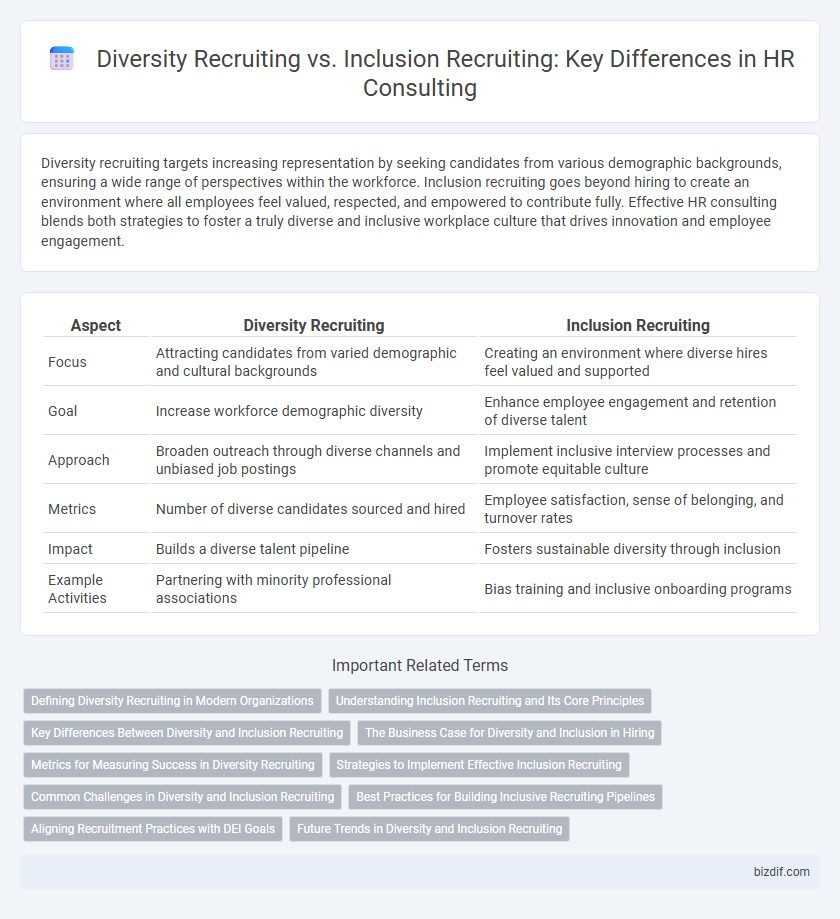Diversity recruiting targets increasing representation by seeking candidates from various demographic backgrounds, ensuring a wide range of perspectives within the workforce. Inclusion recruiting goes beyond hiring to create an environment where all employees feel valued, respected, and empowered to contribute fully. Effective HR consulting blends both strategies to foster a truly diverse and inclusive workplace culture that drives innovation and employee engagement.
Table of Comparison
| Aspect | Diversity Recruiting | Inclusion Recruiting |
|---|---|---|
| Focus | Attracting candidates from varied demographic and cultural backgrounds | Creating an environment where diverse hires feel valued and supported |
| Goal | Increase workforce demographic diversity | Enhance employee engagement and retention of diverse talent |
| Approach | Broaden outreach through diverse channels and unbiased job postings | Implement inclusive interview processes and promote equitable culture |
| Metrics | Number of diverse candidates sourced and hired | Employee satisfaction, sense of belonging, and turnover rates |
| Impact | Builds a diverse talent pipeline | Fosters sustainable diversity through inclusion |
| Example Activities | Partnering with minority professional associations | Bias training and inclusive onboarding programs |
Defining Diversity Recruiting in Modern Organizations
Diversity recruiting in modern organizations focuses on actively seeking and attracting candidates from a wide range of backgrounds, including race, gender, age, ethnicity, and disability, to create a heterogeneous workforce. This approach emphasizes broadening talent pools to enhance innovation and decision-making by incorporating multiple perspectives. Effective diversity recruiting strategies integrate unbiased recruitment technologies and inclusive job descriptions to eliminate barriers and promote equitable opportunities.
Understanding Inclusion Recruiting and Its Core Principles
Inclusion recruiting emphasizes creating a workplace culture where diverse talent feels valued, respected, and empowered to contribute fully, going beyond the basic goal of simply increasing diversity numbers. Core principles include equitable hiring practices, fostering psychological safety, and actively addressing biases throughout the recruitment process to ensure fair opportunity and belonging for all candidates. This approach improves employee engagement, retention, and drives innovation by leveraging diverse perspectives within inclusive environments.
Key Differences Between Diversity and Inclusion Recruiting
Diversity recruiting centers on attracting candidates from various demographic backgrounds to create a heterogeneous workforce, emphasizing metrics like race, gender, and ethnicity representation. Inclusion recruiting focuses on creating an environment where diverse employees feel valued and engaged, emphasizing cultural fit, employee experience, and retention strategies. Key differences lie in diversity's quantitative approach to hiring versus inclusion's qualitative emphasis on workplace integration and belonging.
The Business Case for Diversity and Inclusion in Hiring
Diversity recruiting enhances workforce innovation by attracting candidates from varied backgrounds, resulting in improved problem-solving and increased market reach. Inclusion recruiting ensures equitable hiring practices and employee engagement, fostering retention and productivity by creating a culture where all voices are valued. Companies with diverse and inclusive hiring strategies report 35% higher financial returns and 70% greater innovation revenue compared to industry averages.
Metrics for Measuring Success in Diversity Recruiting
Diversity recruiting success is measured by metrics such as the demographic composition of candidates at each recruitment stage, hire rate of underrepresented groups, and retention rates post-hire. Tracking candidate source diversity and employee engagement scores also provides insight into recruitment effectiveness. Data-driven analysis of these key performance indicators ensures continuous improvement in attracting diverse talent pools.
Strategies to Implement Effective Inclusion Recruiting
Effective inclusion recruiting strategies prioritize creating an environment where diverse candidates feel valued and empowered throughout the hiring process. Implementing structured interview practices, bias training for recruiters, and leveraging employee resource groups enhances candidate engagement and retention. Data-driven approaches to monitor diversity metrics ensure continuous improvement and alignment with organizational inclusion goals.
Common Challenges in Diversity and Inclusion Recruiting
Common challenges in diversity recruiting include overcoming unconscious bias in candidate screening and expanding talent pipelines to access underrepresented groups. Inclusion recruiting faces hurdles in fostering equitable workplace cultures where diverse hires feel valued and supported. Both require strategic efforts to align recruitment practices with organizational diversity goals and inclusive retention strategies.
Best Practices for Building Inclusive Recruiting Pipelines
Diversity recruiting focuses on attracting candidates from varied demographic backgrounds, while inclusion recruiting ensures those candidates feel valued and supported throughout the hiring process. Best practices for building inclusive recruiting pipelines include implementing unbiased job descriptions, offering diverse interview panels, and fostering continuous feedback loops to address potential barriers. Leveraging data analytics to track hiring outcomes and providing inclusive training for recruiters further enhances the effectiveness of inclusive recruitment strategies.
Aligning Recruitment Practices with DEI Goals
Diversity recruiting prioritizes attracting candidates from various backgrounds, emphasizing measurable representation metrics to fulfill DEI goals. Inclusion recruiting focuses on creating equitable hiring processes that support belonging and retention, ensuring diverse talent thrives post-hire. Aligning recruitment practices with DEI objectives requires integrating both strategies to build a workforce that reflects diversity while fostering an inclusive culture.
Future Trends in Diversity and Inclusion Recruiting
Future trends in diversity and inclusion recruiting emphasize leveraging AI-driven analytics to identify diverse talent pools and reduce unconscious bias in hiring processes. Companies increasingly integrate inclusive employer branding and culturally sensitive onboarding practices to enhance employee retention and engagement. Embracing virtual reality simulations and immersive training programs helps foster inclusive workplace cultures that drive innovation and competitive advantage.
Diversity Recruiting vs Inclusion Recruiting Infographic

 bizdif.com
bizdif.com